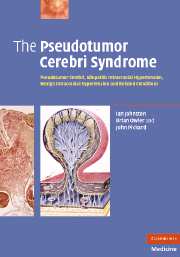 The Pseudotumor Cerebri Syndrome
The Pseudotumor Cerebri Syndrome Published online by Cambridge University Press: 21 August 2009
Introduction
There has been considerable debate about the underlying disease mechanism in PTCS, as recent reviews attest (Sussman et al., 1998; Kosmorsky, 2001; Walker, 2001). As yet, there is no definitive resolution. Several key questions which must be answered if the elucidation of the disease mechanism (or mechanisms) in PTCS is to be achieved may be enumerated as follows:
Is there one of the three intracranial compartments (brain parenchyma, blood, CSF) primarily involved in the volume increase which causes the increase in ICP that characterizes PTCS, or is there a combination of volume increases?
Is it always the same compartment or combination of compartments, or might different compartments be involved in different circumstances, to give the same clinical manifestations?
Is there a single causative mechanism, or at least a ‘final common path’ for the volume increase, either of the primary compartment or the combination of compartments?
What are the compensatory mechanisms involved?
Whichever of the three intracranial compartments is involved primarily or in combination, the increase is fluid. This is obviously so in the case of blood and CSF but must also be so with respect to brain, there being no evidence at all for an increase in solid brain tissue. Moreover, the increase must be capable of being sustained over a long period of time, given the often very chronic nature of the condition.
To save this book to your Kindle, first ensure [email protected] is added to your Approved Personal Document E-mail List under your Personal Document Settings on the Manage Your Content and Devices page of your Amazon account. Then enter the ‘name’ part of your Kindle email address below. Find out more about saving to your Kindle.
Note you can select to save to either the @free.kindle.com or @kindle.com variations. ‘@free.kindle.com’ emails are free but can only be saved to your device when it is connected to wi-fi. ‘@kindle.com’ emails can be delivered even when you are not connected to wi-fi, but note that service fees apply.
Find out more about the Kindle Personal Document Service.
To save content items to your account, please confirm that you agree to abide by our usage policies. If this is the first time you use this feature, you will be asked to authorise Cambridge Core to connect with your account. Find out more about saving content to Dropbox.
To save content items to your account, please confirm that you agree to abide by our usage policies. If this is the first time you use this feature, you will be asked to authorise Cambridge Core to connect with your account. Find out more about saving content to Google Drive.